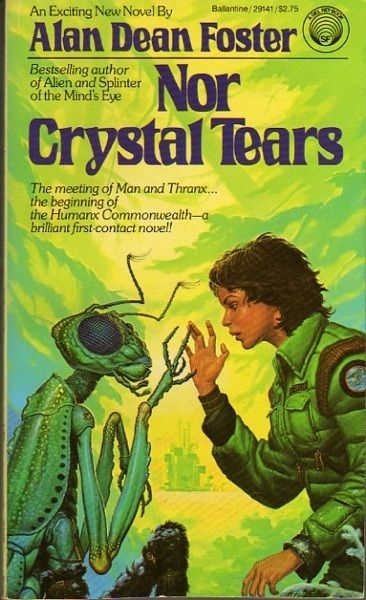A Beautiful Day for a Neighbor
Nor Crystal Tears
By Alan Dean Foster

4 Dec, 2019
Alan Dean Foster’s 1982 Nor Crystal Tears is a standalone SF novel. However, it shares a setting with other novels in Foster’s Humanx Commonwealth.
The partnership of insectile Thranx and mammalian humans created a galactic power. How did this union come to be?
It started with a ship full of hideous alien monsters.
Ryo is a curiosity among the Thranx of his colony world. Unlike the rest of his cohort, he has no idea what his life’s calling might be. Despite this shortcoming, he works hard and finds a degree of success as an agronomist.
From light years away in deep space comes news that transforms Ryo’s life. Captain Brohwelporvot’s starship Zinramm reports finding a damaged ship. The ship is clearly alien but not Aann, the sole star-faring species the Thranx have met thus far. It belongs to a third race, one even more hideous than the Aann!
Exciting news, news that gives Ryo a hint as to his calling: he loves novelty. His initial attempts to find a way to take part in first contact very nearly convince his conservative friends and family to place him in an institution for his and the general good.
Then a clarification is issued. There was no wrecked ship, no third race. The whole matter was a joke that everyone should put out of their mind.
Ryo does not believe the clarification. Since his community disapproves of his obsession, he decides to sneak off and find the aliens. His plans go awry: he is soon robbed and left destitute.
Ryo sees no choice but to start mugging people for the money he desperately needs. He is as bad a mugger as he is a sneak. Providentially, his first intended victim is Wuu, a wealthy poet who takes pity on Ryo. Rather than turn the hapless agronomist over to the authorities for conditioning, the poet underwrites Ryo’s efforts to find the aliens.
Possibly because of the average Thranx’s docility, the authorities are inept at concealing top secret facilities. Ryo deduces where the aliens are being held. While reconnoitering, he is kidnapped by two escaping aliens.
Why have the aliens been held? Thranx scientists are convinced the aliens are intrinsically violent and xenophobic, even more so than the Aann. Like the Aann, the strangers are inside-out mammals that remind the scientists of Thranx-eating monsters of the distant past. They must be a threat to the entire Thranx race!
Ryo is convinced that humans and Thranx can be friends, if only communication can be established. What noble intentions! Who could have predicted the result would be a crimewave: prison breakouts, hijacking, physical assault, kidnapping…?
~oOo~
Also, there are a couple of murders, although neither is Ryo’s fault. One is justifiable self-defence.
Readers familiar with Foster’s work will have guessed that Ryo would succeed in establishing human-Thranx ties, as other Foster novels are set in the Humanx Commonwealth (human + Thranx = Humanx). How did this happen? This novel reveals all.
It’s not love at first sight. Humans fear human-sized bugs. The Thranx, ditto, cannot understand how intelligent beings can function with the hard parts inside. Ridiculous and ugly! Nor are the Thranx scientists wrong in thinking that humans are prone to violence: they are. They readily fight each other over minor differences, something that is incomprehensible to the Thranx.
But individuals differ. Ryo understands that any population (even among the Thranx) will include a fair amount of individual variation. He is an outlier for the Thranx (a eccentric who engages in a crime spree); the two humans are outliers in that they can look past appearances and befriend a bug. The average adult Thranx may regard humans with loathing; humans may recoil from Thranx. Nevertheless, there will be enough exceptions on both sides that friendly communication can be established.
Rereading this thirty-seven years later, I wonder to what degree Foster was inspired by Star Trek when he created the Thanx. Budgetary concerns meant that Vulcans looked very human. Foster could imagine aliens who were not at all humanoid. But appearances aside, Vulcans and Thranx share some traits: a reliance on logic and entrenched conservativism.
Unlike your traditional Trek stories, which usually are told from the human perspective, Nor Crystal Tears is told from the alien point of view. Ryo takes a condescending view of the hairless apes. The apes do have some pluses: we are energetic and we can sing and dance.
This attitude seems oddly familiar. I cannot figure out why.
Modern readers might be surprised to discover this book was written as recently as 1982. Foster’s SF feels a generation or two older than it is. His prose is more energetic than polished; his plotting tends to rely on convenient coincidences. This novel would have been right at home in 1962 or even 1952.
Nor Crystal Tears appears to be out of print in North America but it is available from (Amazon UK).
